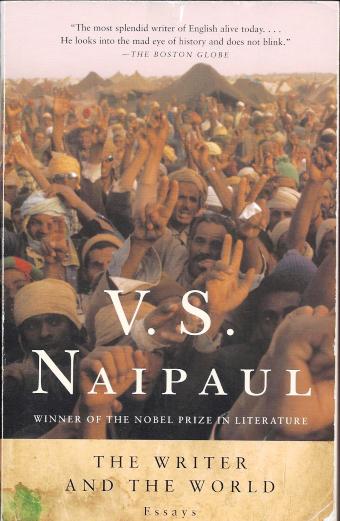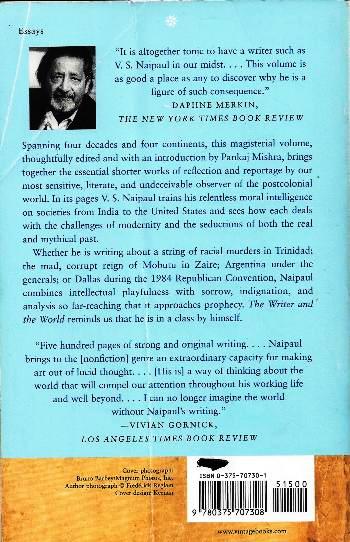|
|
Naipaul's
Book of the World
Hilary
Mantel
Trong cuốn
"Nhà văn và Thế giới", có bài diễn thuyết của Naipaul, Nền văn minh phổ
cập của
chúng ta, “Our Universal Civilization”, tại Học Viện Manhattan, NY. TV
sẽ giới
thiệu, vì nó liên quan tới vấn nạn khủng bố, và cùng với nó, như 1 đối
trọng, “bịnh
Tây Phương”, a “Western disease”. Ngoài ra TV sẽ giới thiệu bài Naipaul
viết về
cuốn sách thân cận với ông nhất, Ngôi nhà cho me-xừ [A House for Mr.]
Biswas. Bài
này cho Mít chúng ta thấy, có 1 cách viết khác hẳn chúng ta thường
viết, do bị ảnh
hưởng của Tẩy, belles lettres, văn là phải đẹp.
Bài trong sách, dài hơn
nhiều, so với bài trên net, và được ghi là Postscript: Our Universal Civilization.
Our
Universal Civilization
Đúng hơn, là bài này:
Our
Universal Civilization
Sir V.S.
Naipaul
On October
30, 1990, V S. Naipaul, considered by many to be the greatest living
English
language novelist, delivered the fourth annual Walter B. Wriston
lecture in
Public Policy, sponsored by the Manhattan Institute. Mr. Naipaul takes
as his
subject the “universal civilization” to which the Western values of
tolerance,
individualism, equality, and personal liberty have given birth. He
describes
the personal and philosophical turmoil of those who find themselves
torn
between their native civilizations and the valued of universal
civilization. We
are pleased to present his remarks here in full.
Diễn văn Nobel
Naipaul Page
Typical sentence
Easier to pick two of them. What’s most typical is the
way one sentence qualifies another. “The country was a tyranny. But in
those days not many people minded.” (“A Way in the World”, 1994.)
Câu văn điển hình:
Dễ kiếm hai câu, điển hình nhất, là cái cách mà câu này
nêu phẩm chất câu kia:
"Xứ sở thì là bạo chúa. Nhưng những ngày này, ít ai "ke" chuyện này!"
Naipaul rất
tởm cái gọi là quê hương là chùm kế ngọt của ông. Khi được hỏi, giá như
mà ông
không chạy trốn được quê hương [Trinidad] của mình, thì sao, ông phán,
chắc nịch,
thì tao tự tử chứ sao nữa! (1)
Tuyệt.
(1)
INTERVIEWER
Do you ever wonder what
would have become of you if you had stayed in Trinidad?
NAIPAUL
I would have killed
myself. A friend of mine did-out of stress, I think. He was a boy of
mixed race. A lovely boy, and very bright. It was a great waste.
Sir V.S.
Naipaul (1932- ): Nobel văn chương 2001
“Con người
và nhà văn là một. Đây là phát giác lớn lao nhất của nhà văn. Phải mất
thời
gian – và biết bao là chữ viết! – mới nhập một được như vậy.”
(Man and writer were the same
person. But that
is a writer’s greatest discovery. It took time – and how much writing!
– to arrive
at that synthesis)
V.S. Naipaul, “The Enigma of
Arrival”
Trong bài tiểu luận “Lời
mở đầu cho một Tự thuật”
(“Prologue to an Autobiography”), V.S. Naipaul kể về những di dân Ấn độ
ở
Trinidad. Do muốn thoát ra khỏi vùng Bắc Ấn nghèo xơ nghèo xác của thế
kỷ 19, họ
“đăng ký” làm công nhân xuất khẩu, tới một thuộc địa khác của Anh quốc
là
Trinidad. Rất nhiều người bị quyến rũ bởi những lời hứa hẹn, về một
miếng đất cắm
dùi sau khi hết hợp đồng, hay một chuyến trở về quê hương miễn phí, để
xum họp
với gia đình. Nhưng đã ra đi thì khó mà trở lại. Và Trinidad tràn ngập
những di
dân Ấn, không nhà cửa, không mảy may hy vọng trở về.
Vào năm
1931, con tầu SS Ganges đã đưa một ngàn di dân về Ấn. Năm sau, trở lại
Trinidad, nó chỉ kiếm được một ngàn, trong số hàng ngàn con người không
nhà nói
trên. Ngỡ ngàng hơn, khi con tầu tới cảng Calcutta, bến tầu tràn ngập
những con
người qui cố hương chuyến đầu: họ muốn trở lại Trinidad, bởi vì bất cứ
thứ gì họ
nhìn thấy ở quê nhà, dù một tí một tẹo, đều chứng tỏ một điều: đây
không phải
thực mà là mộng.
Ác mộng.
“Em ra đi
nơi này vẫn thế”. Ngày nay, du khách ghé thăm Bắc Ấn, nơi những di dân
đợt đầu
tiên tới Trinidad để lại sau họ, nó chẳng khác gì ngày xa xưa, nghĩa là
vẫn
nghèo nàn xơ xác, vẫn những con đường đầy bụi, những túp lều tranh vách
đất, lụp
xụp, những đứa trẻ rách rưới, ngoài cánh đồng cũng vẫn cảnh người cày
thay
trâu… Từ vùng đất đó, ông nội của Naipaul đã được mang tới Trinidad,
khi còn là
một đứa bé, vào năm 1880. Tại đây, những di dân người Ấn túm tụm với
nhau, tạo
thành một cộng đồng khốn khó. Vào năm 1906, Seepersad, cha của Naipaul,
và bà mẹ,
sau khi đã hoàn tất thủ tục hồi hương, đúng lúc tính bước chân xuống
tầu, cậu
bé Seepersad bỗng hoảng sợ mất vía, trốn vào một xó cầu tiêu công cộng,
len lén
nhìn ra biển, cho tới khi bà mẹ thay đổi quyết định.
Duyên Văn
1 2
Chính là nỗi đau
nhức trí thức thuộc địa, chính nỗi chết không rời đó, tẩm thấm mãi vào
mình, khiến cho Naipaul có được sự can đảm để làm một điều thật là giản
dị: “Tôi gọi tên em cho đỡ nhớ”.
Em ở đây, là đường
phố Port of Spain, thủ phủ
Trinidad. Khó khăn, ngại ngùng, và
bực bội – dám nhắc đến tên em – mãi sau này, sau sáu năm chẳng có chút
kết quả ở Anh Quốc, vẫn đọng ở nơi ông, ngay cả khi Naipaul bắt đầu tìm
cách cho mình thoát ra khỏi truyền thống chính quốc Âu Châu, và tìm
được can đảm để viết về Port of Spain như ông biết về nó. Phố Miguel (1959), cuốn sách đầu
tiên của ông được xuất bản, là từ quãng đời trẻ con của ông ở Port of
Spain, nhưng ở trong đó, ông đơn giản và bỏ qua rất nhiều kinh nghiệm.
Hồi ức của những nhân vật tới “từ một thời nhức nhối. Nhưng không phải
như là tôi đã nhớ. Những hoàn cảnh của gia đình tôi quá hỗn độn; tôi tự
nhủ, tốt hơn hết, đừng ngoáy sâu vào đó."
In this third instalment of our series on what makes distinctive writers
distinctive, Robert Butler tackles V.S. Naipaul on the eve of his 31st
book
From INTELLIGENT LIFE Magazine, Autumn 2010
V.S. Naipaul was born in Trinidad in 1932, when literacy
among Indian men on the island stood at 23%. Naipaul’s father had
taught himself to read and write and became a journalist for the Trinidad
Guardian. He gave his son the idea of the writer’s life and the
idea that it was a noble calling. The young Vidia slept on the
verandah, where the varied life of Port of Spain, captured in his first
book “Miguel Street” (1959), “unrolled every day in front of my eyes”.
The conditions that made his literary ambitions so raw and improbable
also gave Naipaul his unique perspective. His early exposure to
Trinidad’s diverse population—Africans, East Indians, Venezuelans,
Chinese, Portuguese, Americans, Syrians and Lebanese—ensured that he
wouldn’t sentimentalise other cultures. This gift was immeasurably
deepened by his travels in South America, Africa, India, Pakistan, Iran
and South-East Asia.
Naipaul attaches equal value to his fiction and
non-fiction and has mastered (as the Nobel committee said) a form of
writing that combines the two. His 31st and latest book, “The Masque of
Africa” (out now in Britain, and in October in America), sees this
tireless observer return, albeit in a slightly more leisurely style
(“we went in his ambassador’s car”), to a continent he first visited 44
years ago.
Golden rule
After university, Naipaul decided the way he had written
undergraduate essays was not “proper writing”. He set himself the task
of learning to write all over again, this time using only simple direct
statements. “Almost writing ‘the cat sat on the mat’. I almost began
like that.” For three years he stayed with those rules. He recently
provided a list of seven rules for beginners at the request of an
Indian newspaper: (1) write sentences of no more than ten to 12 words;
(2) make each sentence a clear statement (a series of clear linked
statements makes a paragraph); (3) use short words—average no more than
five letters; (4) never use a word you don’t know the meaning of; (5)
avoid adjectives except for ones of colour, size and number; (6) use
concrete words, avoid abstract ones; (7) practise these rules every day
for six months.
Key decision
To discard the metropolitan notion of the writer that he
had grown up with—a Somerset Maugham or Evelyn Waugh who moves from a
place of civilised security to investigate the world beyond his own
shores. That kind of “I” was not available to Naipaul. “My subject was
not my sensibility, my inward development, but the worlds I contained
within myself.” (“The Enigma of Arrival”, 1987.)
Strong point
Something he admires in other writers: “Kipling looked
hard at a real town.”
Favourite trick
In his later work, he repeats a phrase from one
paragraph in the next one, which gives his prose an almost biblical
sense of progress. The mythic tone is heightened by short words and
inverted sentences: “In the morning there came the fighter plane.” (“A
Bend in the River”, 1979.) Every evening Naipaul reads out loud what he
has written during the day. Or used to—nowadays he has what he has
written read out to him. This lifelong habit gives his prose the
weightiness of considered thought and the lightness of conversation.
Role models
His father—“possibly the first writer of the Indian
diaspora”—for his short stories about Trinidad’s Indians. Joseph
Conrad, for seriousness and a sense of those living on “the other side
of the fence”. Flaubert, for the “selection and achievement of
detail”. Shakespeare, for freshness of language and the power of his
simplest lines.
Typical sentence
Easier to pick two of them. What’s most typical is the
way one sentence qualifies another. “The country was a tyranny. But in
those days not many people minded.” (“A Way in the World”, 1994.)
"The Masque of Africa"
was published by Picador on August 31st, and by Knopf in America on
October 19th
|
|



